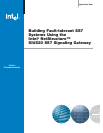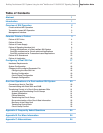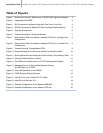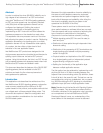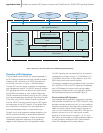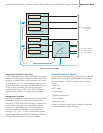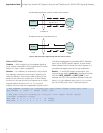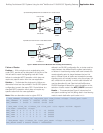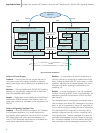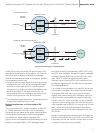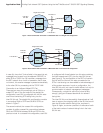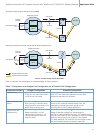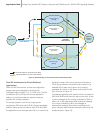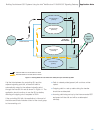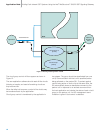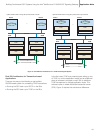
Abstract
In order to achieve five-nines (99.999%) reliability and a
high degree of fault tolerance in an SS7 environment
using Intel
®
NetStructure™ SIU520 signaling gateways,
an SS7 end point spread over two signaling interface
units (SIUs) and multiple application servers can be
configured and deployed. Splitting the protocol
processing functionality of a signaling point by
implementing an SS7 node over two SIUs isolates the
hardware processors on the chassis from each other.
This separation lets one processor continue if the other
fails, allowing the system to remain in service. Distributing
application processing of a signaling point on multiple
application servers not only increases the total capacity
of a system, but also offers a higher level of fault
tolerance in the user application space.
Intel NetStructure SS7 products are designed for this
dual-processor approach and provide the architecture for
splitting a point code over two active SS7 protocol
engines. Using this technique, the links in an SS7 link set
can be spread between two separate chassis when Intel
NetStructure SS7 boards are installed in each.
This document describes the features of the SIU520 SS7
signaling gateway that are available to build SS7
solutions and reach the five-nines requirements of
telco-grade service platforms.
Introduction
This application note describes the architecture of the
Intel NetStructure SIU520 signaling gateway, reviews the
most common potential points of failure of an SS7
system based on this product, and explains methods that
can mitigate each of these potential failure points. This
document also explains in detail the configuration and
run-time operation considerations of a dual-resilient
SIU520-based system.
Because of the high expectation of service reliability by
the users of public telephone networks, equipment
manufacturers and system integrators demand high
levels of fault tolerance and availability, often citing the
five-nines for availability (requiring a system to be
operational for 99.999% of the time).
These systems need to continue to offer service even
when partial hardware or software failure has occurred.
There are several well-known methods of achieving this
type of reaction to partial failure in the signaling
component of communications networks, including:
■
Multiple signaling paths (SS7 links and link sets) to
each end point
■
Distribution of these paths through independent inter-
faces and cabling
■
Distribution of the processing of SS7 terminations at a
single signaling point between multiple processing
cards in a single SIU
■
Physical isolation and duplication of the SS7 interface
for a single signaling point on independent protocol
engines sharing a single point code
■
Splitting the functionality of the application layer
between multiple application servers
The first method can be achieved by implementing multi-
ple links (64 Kb/s or 56 Kb/s channels) between two
adjacent inter-communicating points. (By definition, these
links will all be in the same link set.) The last two can be
accomplished by using two independent, but co-operat-
ing, SIU520s relaying the SS7 signaling to a distributed
application layer split over multiple application hosts.
Note: Readers should be familiar with Signaling System
7 (SS7) concepts. They should also be aware that the
information contained in this application note is provided
as a complement to the Intel NetStructure SIU520
Developer’s Manual; hence, an understanding of the
terms defined in the developer’s manual is assumed.
Building Fault-tolerant SS7 Systems Using the Intel
®
NetStructure™ SIU520 SS7 Signaling Gateway Application Note
1



